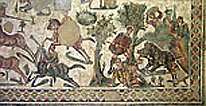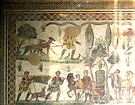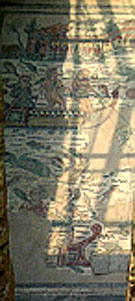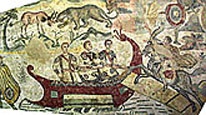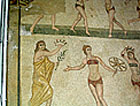April-May 2005 in Italy and Malta
Click on any thumbnail to see a larger image
Pages
April
17-22 Rome
Arrival in Rome,
Tourists in
Rome
April
22-24 Bay of Naples
Herculaneum,
Sorrento,
Vesuvius
April 24-27 Capri
April
27-29 Amalfi to Maratea
Amalfi Coast and
Paestum,
Maratea
April
29-May 3 Sicily
To Sicily,
Sicily (Taormina),
Mosaics at Villa Imperiale
di Casale,
Etna,
Valley of the Temples,
Siracusa
May
3-6 On
Malta
Blue Grotto and Temples,
Valetta
and Archaeological Museum,
Exhibits in Archaeological Museum
Hypogeum,
Gozo and Ggantija,
Tarxien
and Clapham Junction
May 6-7 Sicily, Scilla and Charybdis
May 7-8 Tropea (Capo Vaticano)
May
8-10 Puglia
Matera,
Grotto, Trulli of Alberobello
May 10-12 Abruzzi National Park
May 12 Tivoli, Villa Adriana
Mosaics of the Villa Imperiale di Casale
The next day we made a trip to the middle of Sicily, to see the famous 2nd centry A.D. Villa Imperiale di Casale. The road from Giardini-Naxos is mostly by autostrada, first to Catania and then on the Catania to Palermo road. The first part of the Catania-Palermo autostrada goes through an agricultural plain west of Catania. That part is largely elevated a two or three metres above the fields on a kind of long viaduct, and the road itself is crossed by quite a few aqueducts (modern ones, not Roman). Presumably the idea was to minimize the impact of the highway on the natural water flow in the fields.
 |
 |
 |
| Typical vista in central Sicily | Piazza Armorina | Outside the entrance to the Villa |
On the way to the Villa, one is treated to many wide vistas, green at this season but probably brown and dusty in the high summer. We saw so may amazing landscapes in Sicily that we became quite blasé about them after a couple of days.
The Villa is near the modern town of Piazza Armorina, south of the central city of Enna. Piazza Armorina was so named because one of the fighting feudal warlords drilled his troops in the main Piazza there in the 16th century or thereabouts. The town now is busy and uninviting, but quite picturesque from a distance.
One doesn't go to Piazza Armorina to visit the town. It's the Villa and its astounding mosaics that are the attraction. Their artistry, the sheer area of flooring covered, the variety of themes and of aritstic styles, all these contribute to an overwhelming impression of wealth, family, grandeur, and simple fun.There are pictures of family life, of mythology, of wild life capture, of sporting events both real and charicatured, of fishing, of simple geometric intricacy.. The Villa was obviously owned by someone exceedingly rich and important. It isn't siituated in a place that seems very suitable for governing Sicily, central though it may be. It is at the bottom of a river valley, impossible to defend in case of trouble, near no obvious routes to important seaports, and generally much better suited as a palatial resort than as an official residence I show a few of the hundred or so pictures I took.
These are but a few of the many different scenes in the Villa. Several of them, including all those involving getting exotic animals onto ships, are elements of the floor of a long hallway, filled with action.
I must say a word about these pictures. The floors were quite dusty and brightly sunlit when we visited, so the mosaics were quote indistinct to the naked eye. We were restricted, for obvious reasons, to walkways above the floors and could see many of the rooms only through doorways at quite oblique angles. What you see here sometimes is shown at the oblique angle, sometimes with the perspective corrected as best I can manage with Photoshop, and in many cases the picture is a composite of two or more photos. Often the composites have chunks apparently missing. This occurs because of the perspective correction, which means that more of a rectangular area wasvisible to the camera in the distance than up close. In all cases the dusty overlay has been removed by manipulating the image brightness and contrast. For this reason, the colours may not be exactly as they would be if the mosaics were seen after being washed down, bit I think most of them are probably fairly close.

